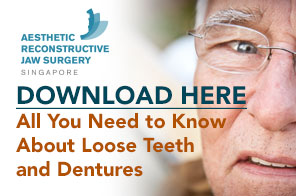Share this
Three Options for Replacing Missing Teeth or Loose Teeth in Singapore
on February 20, 2014
 If you have missing or loose teeth, weighing your replacement options carefully is important. After all, the quality of your dental restoration will affect your everyday life in terms of comfort, oral function and appearance for years to come. Your three basic options include a fixed dental bridge, dentures and implant-based dental restorations. Knowing the advantages and disadvantages of each can help you make informed decisions about which will best serve your individual needs.
If you have missing or loose teeth, weighing your replacement options carefully is important. After all, the quality of your dental restoration will affect your everyday life in terms of comfort, oral function and appearance for years to come. Your three basic options include a fixed dental bridge, dentures and implant-based dental restorations. Knowing the advantages and disadvantages of each can help you make informed decisions about which will best serve your individual needs.
Fixed Dental Bridges
Fixed dental bridges can replace a single tooth or several. Typically, they consist of two crowns, between which are placed one or more artificial teeth. The crowns will be fitted onto natural teeth at each end of the gap to be filled, holding the bridge in place. A well-made and properly placed bridge is an attractive and comfortable option for replacing missing teeth.
However, they do have disadvantages. Crowning adjacent teeth involves altering them, which can weaken their structure. Supporting a bridge can place undue stress on natural teeth. Both issues can cause more dental problems. Fixed bridges offer no protection against bone loss, which occurs in areas of the jawbone where teeth have been lost, and they are not permanent, with an average lifespan of 7 to 10 years.
Removable Dentures
Replacing missing teeth with dentures is also an option. Partial dentures can be used to replace a single tooth or several, while full dentures replace all teeth in one jaw or both. Partial dentures most commonly consist of one or more artificial teeth on gum-colored base, with clasps at each end, which slip over natural teeth for retention.
Full dentures generally consist of a full set of teeth, commonly made of acrylic or porcelain, set into an acrylic base. They are held in place by support from the gum ridge and underlying bone. Upper dentures also use suction between the roof of the mouth and the denture to aid retention.
Dentures, if they are well-made and precisely fitted, can provide an attractive and functional dental restoration, but are not a perfect solution. Disadvantages include damage to adjacent teeth by partial dentures, and full dentures for the lower jaw are often unstable, since they have less support than upper ones. Additionally, both partial and full dentures loosen over time with bone loss and must be relined or replaced every 5 to 7 years.
Implant-Based Restorations
Replacing missing teeth with implants may be the best option. Dental implants can be used to replace a single tooth, several teeth or all teeth in one or both jaws. In single tooth replacement, a dental implant is surgically placed into the jaw and will bond with the jawbone, much like a natural tooth root. Then, an abutment is mounted on the implant to hold a prosthetic tooth. For the replacement of several teeth, two or more dental implants can be placed to secure a permanent bridge. Restoration of total tooth loss generally consists of 4 to 8 implants topped with a complete arch of replacement teeth.
Advantages of implant-based restorations include protection against bone loss, since the implants provide stimulation to the jawbone much like natural tooth roots do, helping it stay strong and healthy. Anchored into the jawbone like natural teeth, implant-based restorations are self-supporting, doing no harm to adjacent teeth. They function, feel and look like natural teeth, and with good oral hygiene and regular checkups, can last a lifetime.
Whichever option you decide upon, getting started as soon as possible is important to prevent further dental problems, such as undue wear or drifting in remaining natural teeth and bone loss. Of course, being able to eat and speak properly is important too, as is having your best smile possible.
Share this
- Jaw Surgery (93)
- Dental Implants Singapore (90)
- Orthognathic Surgery (48)
- Replacing Missing Teeth (26)
- Missing Teeth Options (23)
- Underbite (23)
- Bone Grafting (21)
- Costs (18)
- Facial Aesthetics (18)
- Aesthetics (17)
- dental implants (16)
- corrective jaw surgery (15)
- BOTOX (11)
- Dermal Fillers (11)
- Wisdom teeth (10)
- Fixed Implant Dentures (8)
- Loose Dentures Singapore (6)
- Medisave (6)
- sleep apnea (6)
- Braces (5)
- Dental Pain (5)
- Dentures in Singapore (5)
- Loose Teeth (5)
- Tooth Extraction (5)
- jaw deformities (5)
- bimax (4)
- bone graft (4)
- maxillomandibular advancement (4)
- all-on-4 (3)
- bimaxillary protrusion (3)
- chin implant (3)
- facial asymmetry (3)
- full mouth dental implants (3)
- genioplasty (3)
- immediate implant (3)
- removal of an integrated dental implant (3)
- third molars (3)
- wisdom tooth surgery (3)
- My Dentures Don't Fit (2)
- VME (2)
- bone graft healing (2)
- distraction osteogenesis (2)
- medical tourism (2)
- obstructive sleep apnea (2)
- orthodontics (2)
- plastic surgery (2)
- CT guided dental implants (1)
- Double jaw surgery (1)
- Invisalign (1)
- Periodontal Disease (1)
- Permanent Dentures Singapore (1)
- before and after photos (1)
- facial trauma (1)
- fractured dental implant (1)
- oral appliance therapy (1)
- root canal treatment (1)
- veneers (1)
- vertical maxillary excess (1)
- September 2019 (2)
- July 2019 (2)
- May 2019 (2)
- August 2018 (1)
- October 2017 (1)
- September 2017 (2)
- August 2017 (1)
- June 2017 (2)
- May 2017 (4)
- April 2017 (1)
- March 2017 (1)
- February 2017 (3)
- January 2017 (3)
- December 2016 (1)
- November 2016 (2)
- October 2016 (4)
- September 2016 (9)
- August 2016 (5)
- July 2016 (11)
- June 2016 (14)
- May 2016 (6)
- April 2016 (2)
- March 2016 (1)
- January 2016 (7)
- December 2015 (10)
- November 2015 (4)
- October 2015 (9)
- September 2015 (7)
- August 2015 (1)
- July 2015 (6)
- June 2015 (3)
- May 2015 (7)
- April 2015 (5)
- March 2015 (8)
- January 2015 (5)
- December 2014 (7)
- November 2014 (7)
- October 2014 (6)
- September 2014 (8)
- August 2014 (5)
- July 2014 (7)
- June 2014 (8)
- May 2014 (9)
- April 2014 (10)
- March 2014 (6)
- February 2014 (8)
- January 2014 (3)
Subscribe by email
Email subscription




Comments (1)